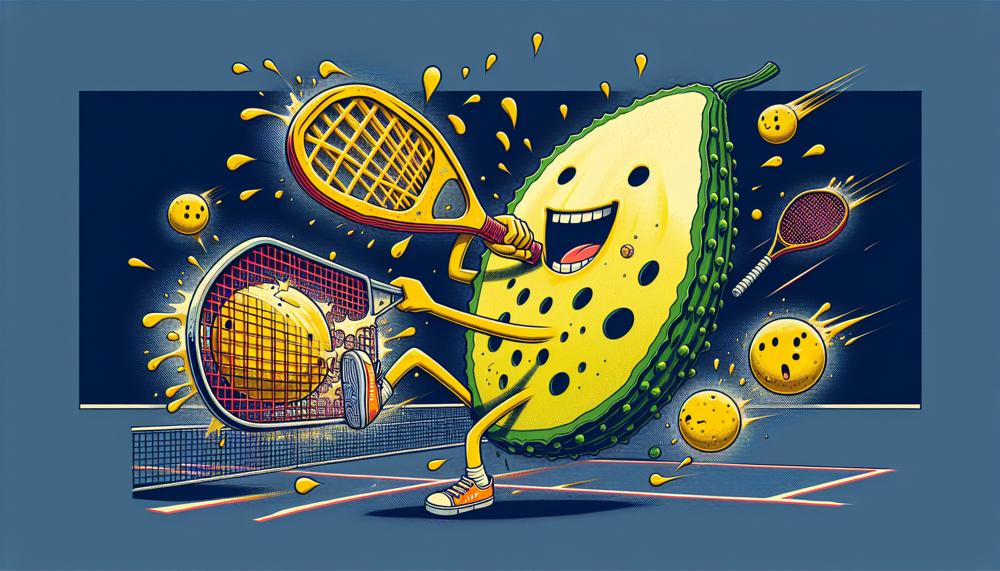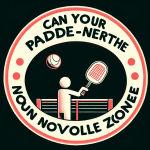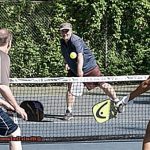Pickleball has exploded in popularity, captivating players of all ages with its unique blend of tennis, badminton, and ping-pong.
And while there are many techniques and shots to master in this fast-paced game, one stands out above the rest: the smash. This powerful shot has a reputation for turning the tide of a match and conjures up images of intense competition and skilled players dominating the court.
But what exactly is a pickleball smash? In this blog post, we’ll delve into the details of this impressive move, exploring its origins, technique, and strategic use.
So grab your paddle and prepare to discover everything you need to know about the ultimate weapon in pickleball—the mighty smash.
Table of Contents
What is a Smash in Pickleball?
For those familiar with racket sports, pickleball is a well-known game that combines elements from tennis, badminton, and ping-pong. Played on a smaller court with wooden paddles and a plastic ball, this game has gained popularity in recent years. But what exactly is a smash in pickleball? And how can you use it to gain an advantage on the court? In this guide, we will delve into the crucial elements of a successful pickleball smash and its strategic use in the game.
The Fundamentals of a Pickleball Smash
A pickleball smash is an offensive shot utilized to return high balls or lobs from one’s opponent. Typically executed with power and speed through overhand hits, the goal is to place the ball out of reach for the opponent. The key components of a successful pickleball smash include proper form and technique. This involves utilizing your entire body to generate power, keeping your elbow elevated, and snapping your wrist at the point of contact.
Strategic Implementation of the Pickleball Smash
The pickleball smash is widely regarded as one of the most effective offensive shots in the game. It can be used strategically to take control of points and apply pressure on one’s opponent. However, there are specific rules and limitations when it comes to performing a smash in pickleball. For instance, smashing from the “kitchen” area near the net is prohibited, and deliberately targeting an opponent’s body is also not allowed.
Common Mistakes to Avoid
While the pickleball smash can be a game-changing shot, it is crucial to steer clear of common errors when executing it. Flawed mechanics and mistimed hits can result in mistakes or missed opportunities. Hence, it is essential to practice proper form and timing to achieve success on the court.
Defending against a Pickleball Smash
As with any offensive shot, defending against a pickleball smash requires anticipation, quick reflexes, and clever strategies. Keep a close eye on your opponent’s body positioning and be prepared to move swiftly to return the shot. Additionally, try mixing up your shots to keep your opponent on their toes and guessing.
How do I smash in pickleball?
Pickleball has become a popular racket sport in recent years, known for its fast-paced and exciting gameplay. One of the most crucial shots in pickleball is the smash, also known as the overhead shot or ace. This powerful shot, executed from above the head, can either end a rally or throw off opponents. In this guide, we will delve into the intricacies of perfecting the pickleball smash.
Also read: The Importance of a Properly Ready Position.
The key to executing a successful smash in pickleball begins with having a proper, ready position. This means keeping your feet shoulder-width apart, your knees slightly bent, and your weight evenly balanced. Additionally, your paddle should be positioned in front of your body, ready to strike the ball.
Also read: The Backswing Motion
As the ball approaches you, take a step back with your non-dominant foot to generate power from your core and hips. This backswing motion allows for increased power and control when hitting the ball.
Also read: The Power-Packed Forward Swing.
Next comes the explosive forward swing, where you use your hips and core to drive the paddle forward and downwards towards the ball. This motion generates the power needed to execute a successful smash.
Also read: Finishing Strong
To complete the smash, follow through with your paddle below waist level for safety. This follow-through ensures that you maintain control over the shot and can quickly recover for the next one.
Also read: The Importance of Footwork.
Proper footwork is essential for executing a successful smash in pickleball. For right-handed players, positioning your right foot behind the left one and aligning your torso perpendicular to the net can provide more power and control when hitting overhead shots.
In addition to these key steps, it is vital to mix up your shots and use strategy rather than relying solely on power. The ATP style of play focuses on strategy and can greatly improve your chances of executing a successful smash in pickleball.
Learning the terminology of pickleball, such as “dink,” “lob,” and “volley,” can also enhance your understanding and enjoyment of the game. Effective communication with your partner and opponents during a match is crucial, and knowing these terms will help you do so.
In conclusion, mastering the pickleball smash requires a combination of proper technique, footwork, and strategy. By following these key steps and familiarizing yourself with the terminology of the game, you can become a skilled pickleball player.
Types of Smashes in Pickleball
Pickleball is a thrilling and fast-paced racquet sport that has been taking the sports world by storm in recent years. This unique game combines elements of tennis, badminton, and table tennis, making it an exciting and challenging sport for players of all ages and skill levels.
Among the many exhilarating shots in pickleball, the smash, also known as an “ace,” stands out as a force to be reckoned with. In this guide, we will delve into the different types of smashes that can be used in conjunction with pickleball smashes to dominate the court.
The Smash Chronicles:
- The Standard Smash: The standard smash is a powerful and aggressive shot that involves striking the ball with tremendous force, directed at a sharp downward angle into the opponent’s court. This shot is often used to end a rally or throw opponents off balance.
-
The Lob Smash: The lob smash is a variation of the standard smash that involves hitting the ball with a higher trajectory, aimed towards the back of the opponent’s court. This shot is highly effective at catching opponents off guard and forcing them to scramble out of position.
- The Drop Smash: The drop smash is a deceptive shot that requires hitting the ball with a low trajectory, aimed towards the front of the opponent’s court. This shot can be used to create an opening for another shot or surprise opponents.
-
The Spin Smash: The spin smash involves adding spin to the ball while executing a standard smash. This shot can be challenging for opponents to anticipate and can produce unpredictable bounces.
- The ATP Smash: The ATP (Advanced Tactical Pickleball) style of play prioritizes strategy over power. The ATP smash involves using precision and placement instead of force to hit winners and outsmart opponents.
Tips for Executing a Successful Smash:
To master the pickleball smash, players must have a strong understanding of the game’s fundamentals and use proper mechanics. Here are some tips to help you perfect this powerful shot:
- Focus on proper footwork and positioning to be in the ideal spot for a smash.
- Take a few steps while swinging the racquet overhead to generate maximum power.
- Snap your wrist and elbow quickly to hit the ball with maximum force.
- Keep your eye on the ball and aim for the “sweet spot” of the paddle for accuracy.
Pickleball Smash Rules
When it comes to pickleball, there is no shot more exhilarating and dominating than the smash. It is a fierce strike aimed with precision towards your opponent’s court, making it nearly impossible for them to retaliate. However, executing a flawless smash demands more than just raw power. It requires precise technique, agile footwork, and strategic thinking. In this guide, we will deconstruct the steps to achieving pickleball smash mastery.
Step 1: Strategic Positioning
The first step to mastering the pickleball smash is strategic positioning. You must swiftly maneuver yourself to the optimal position under the ball. This allows you to set up and prepare for the shot.
Step 2: Establish Your Stance
Once you have reached the ideal position, establish your stance with your feet shoulder-width apart. This will provide a stable foundation for generating explosive power.
Step 3: Raise your hands and point
Raise your non-paddle hand and point towards the ball. This aids in tracking the ball and preparing for the strike. Next, lift your paddle hand and point your paddle towards the ball. This will guide your aim with precision.
Step 4: Step forward
As you swing your paddle, step forward with your non-paddle foot. This adds momentum to your shot, creating more force.
Step 5: Swing Upward in a Circular Motion
While stepping forward, swing your paddle upward in a circular motion. This generates greater power and imparts topspin on the ball.
Step 6: Strike at the Highest Point
Make sure to strike the ball at its apex. This leaves your opponent with minimal time to react and heightens the difficulty of returning the shot.
Step 7: Follow through
Finally, follow through with your swing after making contact with the ball. This adds extra power and finesse to your smash.
Diverse Types of Pickleball Smashes
There are numerous types of pickleball smashes at your disposal, depending on the situation. These include:
- Standard Smash: The most commonly used smash in pickleball, executed with maximum power and velocity.
- Lob Smash: Employed when your opponent is at the net, hitting the ball over their head towards the back of the court.
5 Tips for Defending Against a Smash
For those just beginning their journey into the world of pickleball, the flurry of terms and tactics may seem overwhelming. But fear not, for we have you covered with these five valuable tips on how to defend against a smash in this wildly popular racquet sport.
Strategize your court positioning.
The key to defending against a smash is finding the optimal position on the court. Position yourself near the back line, at the center of the court, to give yourself enough time to react to any shots. This will also allow you to cover more ground and anticipate where the ball will land.
Observe closely and predict.
As the ball hurtles towards you, keep your eyes locked on its trajectory and try to predict where it will land. This split-second advantage will help you position yourself for a successful return shot. Be ready to move swiftly and adjust your stance as needed.
Assume a stable and low-stance
Once you have determined the direction of the ball, get into a low and balanced stance. This will provide you with stability and enable you to make quick movements to reach the ball. Keep your knees bent and your paddle lowered, poised to respond to any shots.
Emulate a Volleyball Player Digging a Spiked Shot
When defending against a smash, it is crucial to mimic the technique used in volleyball when digging a spiked shot. Bend your knees and place your paddle down, preparing yourself to absorb the impact of the ball. This will help you beat the ball to its destination and execute a successful return shot.
Avoid defending shots at chest or head level.
In pickleball, there is rarely a need to defend shots at chest or head level, unless they are aimed at your feet. These shots are typically headed out of bounds and do not require a response. Instead, focus on positioning yourself for return shots directed at your feet.
Bonus Tip: Master the Lingo
Pickleball has its own unique jargon that can be perplexing for newcomers. Familiarizing yourself with the terminology, such as “dink,” “lob,” and “volley,” can enhance communication with other players and help you understand their tactics.
Tips for Smashes in Pickleball
Pickleball is a fast-paced and exhilarating sport that combines elements of tennis, badminton, and table tennis. However, as with any new sport, beginners may find themselves making common mistakes that can hinder their performance on the court.
In this blog post, we will delve into some of the most common mistakes made by beginners in pickleball and provide valuable tips on how to avoid them.
Rushing up to the net after serving
One of the most frequent mistakes made by beginners in pickleball is rushing up to the net after serving. This can leave them vulnerable to their opponent’s return shot, as they have limited time to react and cover the court. Instead, it is crucial to stay back near the baseline after serving until you have a clear idea of where your opponent’s return is going. This will give you more time to react and position yourself for the next shot.
Overusing spin on shots
While adding spin to shots can be an effective strategy in pickleball, beginners often make the mistake of using it excessively on every shot. This can result in the ball going out of bounds or landing into the net. Instead, focus on using spin sparingly and strategically, such as when attempting a drop shot or a lob.
Attempting an overhead smash on every high ball
The overhead smash, also known as an ace, is a powerful shot that can end a rally or keep opponents off balance. However, beginners often make the mistake of trying to smash every high ball, even when it is not a suitable opportunity to do so. It is crucial to recognize when a ball is not smashable and either hit a soft shot or reset the rally by hitting a deep shot.
Ignoring kitchen line rules
The kitchen line, also known as the non-volley zone, is a vital aspect of pickleball rules. Beginners often make the mistake of stepping into the kitchen while volleying, resulting in a fault. It is critical to keep your feet behind the kitchen line when volleying and only step into the kitchen when the ball bounces.
Inadequate serving techniques
Serving is a crucial part of pickleball, and beginners should focus on having proper serving techniques. Aim for a deep and consistent serve, as this will give your opponent less time to react and put you in a better position for the next shot.






